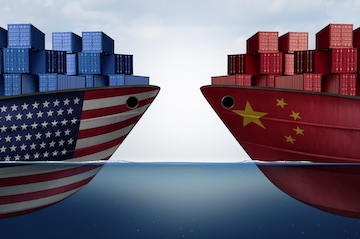
The trade war between the U.S. and China is affecting merchants in both countries. One U.S. example is Seattle-based Rad Power Bikes, which imports electric bicycles from China. Those bikes now incur a 25-percent tariff.
The trade war between the United States and China has been going on for over a year, with each side ratcheting up both rhetoric and retaliatory tariffs. A new round of U.S. tariffs on additional Chinese goods is looming. What follows is my analysis of the effects on ecommerce in both countries and possible future consequences.
In July 2018, the Trump administration imposed a 25 percent tax on more than 800 categories of Chinese-made products. Apple, Dollar Tree, and Keurig Dr Pepper have filed letters of opposition to the administration’s plan for 25-percent U.S. tariffs on another $300 billion of Chinese manufactured goods, including iPhones, MacBooks, and single-serve coffee brewers.
Advantage China?
The advantage in this imbroglio seems to be with the Chinese. Besides finished goods, the U.S. also imports parts from China for manufacturing. The tariffs affect these parts, and the supply chain is complex. The Chinese import mostly soybeans, pork, and cotton from the United States. Finding a new supplier of soybeans is much easier than sourcing new manufacturing parts.
For example, air conditioner maker Carrier said tariffs on Chinese-made parts “will result in significant price increases for U.S. consumers of U.S. manufactured HVAC equipment.” Carrier stated that it would take 12 to 18 months to find alternative sources for parts.
Finding a new supplier of soybeans is much easier than sourcing new manufacturing parts.
Ironically, Carrier, a division of United Technologies Corporation, became news in 2017 when President Trump claimed to have saved 700 jobs in Indianapolis when he prevailed upon Carrier not to move a furnace assembly plant to Mexico. More tariffs on parts might cause the company to rethink the decision because Mexico has lower labor costs, allowing the company to absorb some of the tariff levies.
Chinese Ecommerce Sales
Domestic Chinese ecommerce sales will not be much affected by the trade war because of the paucity of finished goods imported to the country. eMarketer predicts that Chinese ecommerce sales will grow 27.3 percent to $1.94 trillion in 2019. China boasts the largest ecommerce market in the world with 54.7 percent of the global ecommerce market. As they become wealthier, the Chinese have become avid purchasers of luxury apparel, but much of that comes from Europe.
Chinese consumers can also buy baby formula (a popular online item) from European manufacturers. Nevertheless, the media coverage of the trade war has caused the confidence of Chinese consumers to slip. Automobiles are one of the major Chinese imports from the United States and the Chinese auto market has slowed.
The trade war is also hurting the country’s overall retail sales. eMarketer has reduced its growth forecasts for China and, as a consequence, now predicts that China will not surpass the United States in total retail sales in 2019 as it originally expected, but rather in 2021.
U.S. Ecommerce
Ecommerce merchants have to decide whether to absorb the increased costs of the tariffs or pass them on to consumers. For many, absorbing such large tariffs is not a feasible long-term strategy.
One direct-to-consumer ecommerce company seems to be willing to take the risk. In August 2018, electric bike manufacturer Rad Power Bikes — which purchases bikes from Chinese manufacturers — announced, “Although we have found ways to absorb much of the impact of the 25% tariff, we are still forced to increase the prices of our U.S. ebike models by $200.”
For many, absorbing such large tariffs is not a feasible long-term strategy.
After customer complaints, in January 2019 the Seattle-based company reversed course. “Starting January 31, 2019, we will be absorbing 100% of the tariff on electric bikes and dropping prices on all ebike models by $200 to their original, pre-tariff prices. Any ebike that was $1,699 is once again $1,499 and any ebike that was $1,799 is back to $1,599…we will also be offering price-matching for anyone who purchased an ebike between January 1, 2019 and January 31, 2019.”
The company’s founders stated, “Since the tariff went into effect, we’ve standardized many of the components across all our ebike models to help lower costs, streamlined our business processes, and improved the relationships we have with our vendors. This has enabled us to lower our overall costs.”
According to data from the Observatory of Economic Complexity, a website created by the MIT Media Lab, U.S. 2019 imports from China are down 12.5 percent. China has lost its place as the top U.S. trading partner, falling to third. U.S. soybean exports to China in 2019 are expected to be one-third of what they were in 2018.
Other Countries
More than 40 percent of the added value in mainland Chinese exports comes from external partners in Japan, South Korea, Singapore, and Taiwan, according to French investment firm AXA IM.
If Chinese manufacturing slows down, those economies will also be affected. U.S.-based manufacturers may turn their attention to countries such as Vietnam and Malaysia that are becoming more business-friendly, though their infrastructure is not as good as China’s.
Amazon Sellers
Jungle Scout, a company that helps small-business sellers on Amazon, conducted a survey of those sellers. It showed that 72 percent of them had experienced a cost per unit increase of at least 17 percent since the beginning of the trade war last summer.
Some analysts predict that certain American merchants will go out of business if they can no longer earn a profit from their sales on Amazon’s marketplace. Amazon could replace them with Chinese-based sellers, according to the analysts. Packages from China valued below a certain threshold get cleared through customs tax-free while American importers must pay duties on bulk shipments. Replacing American sellers on Amazon with Chinese would be an ironic, unintended consequence of the trade war.







